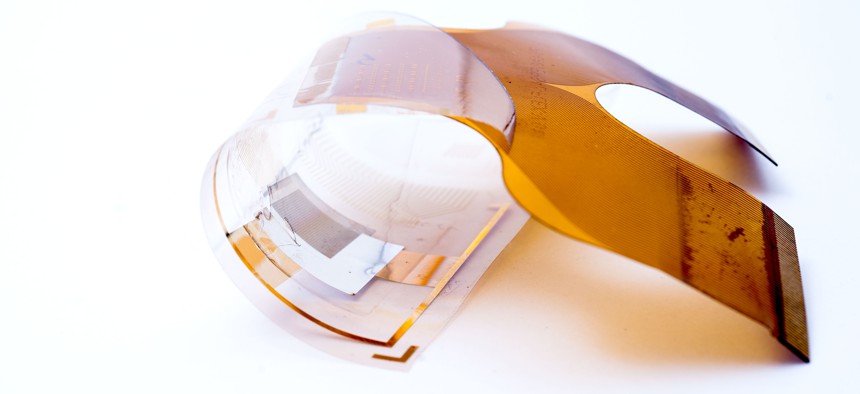
Large-area fully-organic photodetector array fabricated on a flexible substrate. The imager is sensitive in the wavelength range suitable for x-ray imaging applications (developed by imec, Holst Centre and Philips Research.) 2013 IMEC.DE
Flexible Electronics Are the Goal of Pentagon's First Silicon Valley Partnership
Defense Secretary Ash Carter announces a five-year, $171 million effort to make and improve bendable circuitry.
NEWPORT BEACH, Calif. — A partnership to develop electronic components that bend — think touchscreens that wrap around your arm, or aircraft wings made of sensors — is the next step in Defense Secretary Ash Carter’s fast-moving campaign to harness Silicon Valley’s innovation and invite its companies to help create a next-gen military.
On Friday, Carter will announce funding for a new research institute to be run by the FlexTech Alliance, a San Jose-based public-private consortium founded to invent and improve “flexible hybrid electronics.” Over the next five years, the Defense Department will contribute $75 million via the Air Force Research Laboratory, while 96 companies including Apple and Lockheed Martin, 11 labs and universities, and other state and local government partners will pitch in $90 million. The total funding will be $171 million.
"Given what we’ve already done, there’s truly no limit to what we can achieve together,” Carter will say, according to excerpts of his Friday speech provided in advance to reporters traveling with the secretary. “That’s why I’ve been pushing the Pentagon to think outside our five-sided box, and invest in innovation here in Silicon Valley and in tech communities across the country. And now we’re taking another step forward.”
What are flexible electronics? They are ultra-thin silicon bits printed or pasted onto stretchable substrates, freeing computers, their parts, and other electronics from stiff circuit boards and chipsets.
For the consumer market, breakthroughs in flexible electronics could foster an explosion in wearable computers. For the Defense Department, the potential applications start with slashing the size and power consumption of the devices that troops carry. The average Marine today carries an “assault load” of between 95 to 130 pounds, far beyond the recommended 50. The emerging field also holds tremendous promise for the personal and wearable sensors of the sort that the Defense Department is increasingly placing on the backs and fronts of people in uniform. One major application could be new types of computer displays that could fold like a fabric sleeve around a soldier’s arm, replacing heavy and bulky computer equipment.
The Army’s much-hyped Iron Man exoskeleton, the Tactical Assault Light Operator Suit program, or TALOS, which has consumed far more than the $80 million originally allotted to it, could get a big boost from breakthroughs in the area.
Flexible electronics could allow engineers to build new types of robots that are lighter, more resilient, and more useful than today’s highly limited and breakable bots — something like this soft, self-camouflaging specimen developed by Harvard and the Defense Advanced Research Projects Agency.
Perhaps the most important military beneficiary would be aircraft-makers, who could use flexible electronics to fit a lot more stealth, electronic warfare, and communications capabilities onto jets, spy planes and drones.
“For those interested in foreign policy and national security, there are lots of interesting challenges and problems to work on. And that’s also true for those interested in technology. But the intersection of the two is an opportunity-rich environment,” Carter will say in his speech.
Among the national security uses that White House sees: “Dramatically reducing the electronic systems package size and weight through electronics that conform to complex shapes such as aircraft wings or unattended vehicle platforms, and integrating electronics in clothing and fabrics.”
The new organization, called the Manufacturing Innovation Institute, will work to develop “an end-to-end stretchable electronics ‘ecosystem’ in the U.S.” according to the White House.
Carter made the announcement during a visit to the Defense Innovation Unit-Experimental, the Pentagon’s new California office created at lightning speed to convince Silicon Valley inventors and engineers to spend some time and energy ensuring that America's military retains its technological superiority.
Pentagon press secretary Peter Cook explained it this way: “Secretary Carter is demonstrating tangible progress in building relationships with Silicon Valley, which he believes is necessary to help the U.S. military remain on the cutting edge well into the future. The public private partnership he is announcing at Moffett Field will benefit both the future warfighter and customers of a range of U.S. companies, helping the U.S. maintain leadership in manufacturing and innovation for years to come.”



